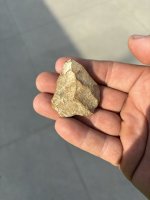CTwoods
Sr. Member
Two years ago, I stumbled onto what must have been a very early homesite or cabin site in a field that is still being plowed each year. My first three 2 hour hunts gave up so many early things like coppers, a 1726 reale, shoe buckles, knee buckle, batwing buckles, thimbles and dozens of very early buttons.
I always waited till fall after harvest and found more each time.
This past winter was mild, so I did hunt there a bit more, and found some stragglers that I missed since I hunted after last fall harvest. But after this spring tilling, I tried it again, but had to quit in less than 10 minutes because I saw fresh seeds that had just been planted. But I found a slick large copper coin in the first 3 minutes! I just went back yesterday now that the corn is a foot tall, so I am now not damaging the crop.
I fully expected to find at least a few early buttons, a couple of coppers, and more broken shoe buckle parts, and relics... But there were almost ZERO hits of non-ferrous targets? I did find only one keeper item; a 1864 indian head, but nothing else old.
I am not a super expert MDer, nor do I have a super machine that could clean everything out down to a foot, so why has the hot spot dried up completely with fresh tilling? I was hoping this field would produce for many years to come, after each tilling. I don't know if they shallow till with a disc harrow, or if they till deeper with a bottom plow, but I am still bewildered on why there was almost nothing yesterday.
I always waited till fall after harvest and found more each time.
This past winter was mild, so I did hunt there a bit more, and found some stragglers that I missed since I hunted after last fall harvest. But after this spring tilling, I tried it again, but had to quit in less than 10 minutes because I saw fresh seeds that had just been planted. But I found a slick large copper coin in the first 3 minutes! I just went back yesterday now that the corn is a foot tall, so I am now not damaging the crop.
I fully expected to find at least a few early buttons, a couple of coppers, and more broken shoe buckle parts, and relics... But there were almost ZERO hits of non-ferrous targets? I did find only one keeper item; a 1864 indian head, but nothing else old.
I am not a super expert MDer, nor do I have a super machine that could clean everything out down to a foot, so why has the hot spot dried up completely with fresh tilling? I was hoping this field would produce for many years to come, after each tilling. I don't know if they shallow till with a disc harrow, or if they till deeper with a bottom plow, but I am still bewildered on why there was almost nothing yesterday.








